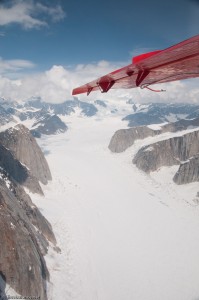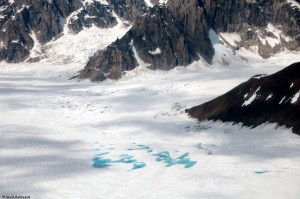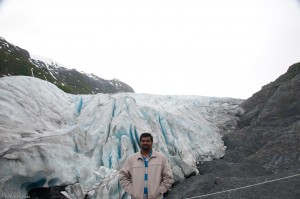PHOTOS: ALASKA

Before we landed in Alaska, I knew intellectually that Alaska had glaciers and that we would see one. But I was totally unprepared for both the ubiquitousness as well as the accessibility to these glaciers. In the course of the few days that we spent in Alaska, we had the opportunity to see the glaciers as we cruised past in a boat, view it from the air, hike up to a glacier on foot, and land on a glacier and experience both the sight and sound of a calving glacier.
As soon as we drove into the town of Girdwood – 30 miles from Anchorage, within a couple of hours of landing in Alaska,  we could see the humongous glaciers that surrounded the town. They looked like snow capped mountains, only we could see that the snow had become packed ice with the distinctive blue color that defines a glacier (apparently purer the ice , deeper the blue color). The next morning, we drove down to Whittier and boarded a catamaran– the Klondike Express–  to see the 26 glaciers promised by the eponymous 26 Glacier Cruise.  Whittier is a tiny town — so tiny that 80% of the town lives in one grey building.  It is also very picturesque: a popular marina with hundreds of boats and yachts anchored  in the Prince William Sound and surrounded by ice-capped mountains.
We could see the glaciers as soon as our catamaran pulled away from the dock.  Our guide provided us with a description of the different kinds of glaciers: alpine glaciers (hanging glaciers—mostly those that cling to mountain sides), tidewater glaciers (valley glaciers that flow down to meet the sea) and piedmont glaciers (when valley glaciers spill onto flat plains).  I watched the scenery as we cruised slowly into the Prince William sound, we chatted casually, with the folks who sat next to us. They were local Alaskans who received this cruise tickets as a freebie and decided to check it out.  They were from near Anchorage and being the small community that Anchorage & nearby Wasilla is – they claimed to know Sarah Palin when she was growing up. I was just about to try to smile in the half amused, half derisive style that Sarah Palin’s mention usually elicits in democratic MD, but I controlled my facial expression when I realized that these people were very proud of her — the local girl who had put Alaska on the map. So I grinned and turned my attention back to the glaciers.
sides), tidewater glaciers (valley glaciers that flow down to meet the sea) and piedmont glaciers (when valley glaciers spill onto flat plains).  I watched the scenery as we cruised slowly into the Prince William sound, we chatted casually, with the folks who sat next to us. They were local Alaskans who received this cruise tickets as a freebie and decided to check it out.  They were from near Anchorage and being the small community that Anchorage & nearby Wasilla is – they claimed to know Sarah Palin when she was growing up. I was just about to try to smile in the half amused, half derisive style that Sarah Palin’s mention usually elicits in democratic MD, but I controlled my facial expression when I realized that these people were very proud of her — the local girl who had put Alaska on the map. So I grinned and turned my attention back to the glaciers.
 Most of the glaciers in the sound were the tidewater glaciers terminating in the Sound. As our boat moved deeper into the fjords, very creatively named after Ivy League colleges (Wellesley, Vassar, Harvard, Yale and so on) , we were soon surrounded by what looked like huge walls of ice— making the boat & me feel quite insignificant in comparison .  There are few sights & sounds that are more awe-inspiring than watching a wall of ice, the height of a 4-5 storeyed building, crash into the ocean with a resounding bang.  As we watched the glacier, chunks of ice kept falling continuously from these tidewater glaciers into the sea – the process is known as calving of a glacier.
Most of the glaciers in the sound were the tidewater glaciers terminating in the Sound. As our boat moved deeper into the fjords, very creatively named after Ivy League colleges (Wellesley, Vassar, Harvard, Yale and so on) , we were soon surrounded by what looked like huge walls of ice— making the boat & me feel quite insignificant in comparison .  There are few sights & sounds that are more awe-inspiring than watching a wall of ice, the height of a 4-5 storeyed building, crash into the ocean with a resounding bang.  As we watched the glacier, chunks of ice kept falling continuously from these tidewater glaciers into the sea – the process is known as calving of a glacier. Massive blocks of ice that had fallen were floating away in the water—all of them with the distinctive blue color. Between the floating ice chunks, we could see sea-otters playing them— it was very clear why they were called the clowns on the sea.  As we made our way back to Whittier at the end of our 5 hour cruise, I wasn’t sure if we actuallydid 26 distinct glaciers on this trip—but the calving glacier alone got me my money’s worth.
Massive blocks of ice that had fallen were floating away in the water—all of them with the distinctive blue color. Between the floating ice chunks, we could see sea-otters playing them— it was very clear why they were called the clowns on the sea.  As we made our way back to Whittier at the end of our 5 hour cruise, I wasn’t sure if we actuallydid 26 distinct glaciers on this trip—but the calving glacier alone got me my money’s worth.
Our next close encounter with a glacier was even more exciting. A couple of days later, while we were driving from Denali National Park to Seward, we stopped at Talkeetna to take a flight seeing tour that actually landed on the glacier. The flight itself was quite awesome, the pilot flew through mountain passes , over the peaks of the several glacier capped mountains that we had seen in the past few days. At one point, he actually cut the engine  and skied the plane down on a slope .   We flew near Mt McKinley – highest peak in United States – and it opened our eyes to see how huge this mountain actually is – it was a completely different ecosystem up high in the mountains. We could barely see the peak of Mt. McKinley from the ground but we could see now that the other mountain peaks, though very high were dwarfed by Mt. McKinley.  Flying over glaciers was like flying on to a completely new planet. While viewing the glaciers from the air, it was easier to comprehend the sheer magnitude of Alaska that is covered by glaciers (~20% of Denali National Park alone is covered by glaciers) And as glaciers move or melt over the course of several centuries, they create many different formations and landforms; from the air, we could see the resulting gorges and valleys carved by glacial ice below. Sometimes, debris and stones and dirt gather on top of the ice and  it forms a thick enough layer to actually grow a forest of coniferous trees on the ice.  However, as we flew to the glacier, the forest on the glacier gave away to an entire field covered with a snow white blanket. Here and there , we saw patches of brilliant blue– the glacier pools.
We flew near Mt McKinley – highest peak in United States – and it opened our eyes to see how huge this mountain actually is – it was a completely different ecosystem up high in the mountains. We could barely see the peak of Mt. McKinley from the ground but we could see now that the other mountain peaks, though very high were dwarfed by Mt. McKinley.  Flying over glaciers was like flying on to a completely new planet. While viewing the glaciers from the air, it was easier to comprehend the sheer magnitude of Alaska that is covered by glaciers (~20% of Denali National Park alone is covered by glaciers) And as glaciers move or melt over the course of several centuries, they create many different formations and landforms; from the air, we could see the resulting gorges and valleys carved by glacial ice below. Sometimes, debris and stones and dirt gather on top of the ice and  it forms a thick enough layer to actually grow a forest of coniferous trees on the ice.  However, as we flew to the glacier, the forest on the glacier gave away to an entire field covered with a snow white blanket. Here and there , we saw patches of brilliant blue– the glacier pools.
 We landed in glacier known as Sheldon Amphitheater. Contrary to what I thought, it was neither very cold nor was it slippery – I thought walking on ice may be tricky. The ground or rather the glacier top felt like powdered snow. It was very quiet, the ice looked pristine and it was a bit surreal to think that we were actually on top of a mountain of ice in the middle of a remote ice-field and all around us were snow covered mountain peaks.  The time on the top of the glacier was rather limited—before we knew it we were on our way back.
We landed in glacier known as Sheldon Amphitheater. Contrary to what I thought, it was neither very cold nor was it slippery – I thought walking on ice may be tricky. The ground or rather the glacier top felt like powdered snow. It was very quiet, the ice looked pristine and it was a bit surreal to think that we were actually on top of a mountain of ice in the middle of a remote ice-field and all around us were snow covered mountain peaks.  The time on the top of the glacier was rather limited—before we knew it we were on our way back.
 Glaciers are generally remote structures. You have to either take a plane to land on a glacier or take a cruise to see one. The best thing about the Exit Glacier in Seward was that it was very accessible by foot–  only a mile away from downtown Seward and we could reach the glacier by a hiking up a short trail.  We had spent the day getting tossed in a boat up Kenai Fjords so I was glad to stretch my legs a bit. The glacier was not that far away— and having seen glaciers from the air and sea, I was eager to walk upto a glacier. We were meandering along the trail rather lazily, pausing a few times to click photographs,  and had almost reached the glacier when Seejo stopped suddenly and announced that there was a bear in front of us. And when he meant in front of us—he really meant it. There was a black bear was less than 5 feet away, and was busy eating the leaves of some tree. Now black bears could be dangerous, bear attacks are not unheard of in such areas. I was busy trying to recall the tips I had read about “What to do when you encounter a black bear†and all I could remember is that if the bear hasn’t noticed you—back away. But I hadn’t contended with Seejo’s love for photography— he started clicking pictures while I furiously whispered promises to kill him if the bear didn’t. I managed to pull Seejo back and then we waited in the distance, till some other people reached there.
Glaciers are generally remote structures. You have to either take a plane to land on a glacier or take a cruise to see one. The best thing about the Exit Glacier in Seward was that it was very accessible by foot–  only a mile away from downtown Seward and we could reach the glacier by a hiking up a short trail.  We had spent the day getting tossed in a boat up Kenai Fjords so I was glad to stretch my legs a bit. The glacier was not that far away— and having seen glaciers from the air and sea, I was eager to walk upto a glacier. We were meandering along the trail rather lazily, pausing a few times to click photographs,  and had almost reached the glacier when Seejo stopped suddenly and announced that there was a bear in front of us. And when he meant in front of us—he really meant it. There was a black bear was less than 5 feet away, and was busy eating the leaves of some tree. Now black bears could be dangerous, bear attacks are not unheard of in such areas. I was busy trying to recall the tips I had read about “What to do when you encounter a black bear†and all I could remember is that if the bear hasn’t noticed you—back away. But I hadn’t contended with Seejo’s love for photography— he started clicking pictures while I furiously whispered promises to kill him if the bear didn’t. I managed to pull Seejo back and then we waited in the distance, till some other people reached there.  Then we waited as a group as the bear finished his meal, did a few stretching exercise right on the trail path. Finally when it moved away, we took the next 50 steps that put us right next to the glacier. It was exactly like what it was— standing next to a huge mountain of blue ice.  I don’t think I can adequately express how overwhelming small the glaciers make you feel.
Then we waited as a group as the bear finished his meal, did a few stretching exercise right on the trail path. Finally when it moved away, we took the next 50 steps that put us right next to the glacier. It was exactly like what it was— standing next to a huge mountain of blue ice.  I don’t think I can adequately express how overwhelming small the glaciers make you feel.  On one hand, it is a pretty blue color ice mountain but you also realize that these are very old formations going back thousands of years.  Seeing the glaciers and landing on them – it felt like we were pioneers, treading where no man has ever gone before. And touching the glaciers was like putting our hands on a part of history.
On one hand, it is a pretty blue color ice mountain but you also realize that these are very old formations going back thousands of years.  Seeing the glaciers and landing on them – it felt like we were pioneers, treading where no man has ever gone before. And touching the glaciers was like putting our hands on a part of history.
